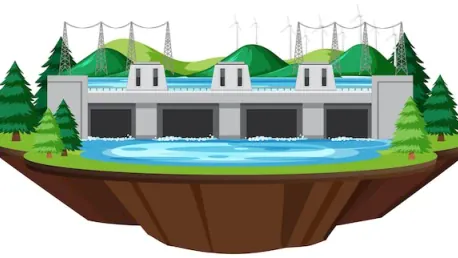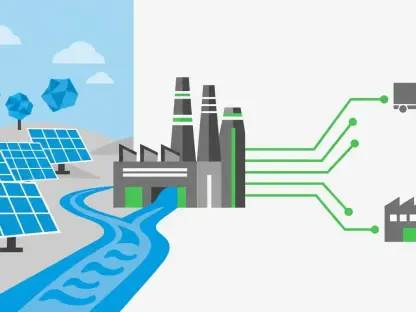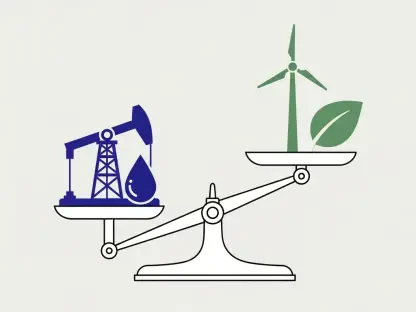Laos, with its abundant water resources and mountainous landscape, has emerged as a focal point for hydropower development in Southeast Asia. Leveraging its natural geography, Laos aims to become a regional leader in renewable energy through strategic public-private partnerships and power purchase agreements with neighboring countries. This ambitious endeavor underscores not only the country’s commitment to sustainable energy but also the immense investment opportunities lying in its hydropower sector.
Leveraging Natural Resources
Laos has utilized its mountainous terrain and ample water resources to propel its hydropower capabilities, which have evolved from small-scale electrification projects to large-scale endeavors like Nam Theun 2 and the Xayaburi Dam. These advancements underscore the country’s ambition and technical expertise in renewable energy. These monumental projects exemplify Laos’s ability to harness its geographical assets, transforming them into significant sources of energy and economic growth.
Hydropower remains central to Laos’ economic strategy, significantly contributing to GDP through electricity exports. The Lao government provides various incentives and opportunities for foreign investors, facilitating the growth of this sector with over 49 operational plants producing substantial energy for both domestic use and export. The capital generated from electricity exports plays a crucial role in national development, funding essential services and infrastructure projects. Thus, Laos continues to bolster its position as the “Battery of Southeast Asia,” supplying clean, renewable electricity to its neighboring countries.
Opportunities for Foreign Investors
Foreign investors can engage with the Lao hydropower market through concession agreements under the Build-Operate-Transfer (BOT) model. Developers finance, construct, and operate facilities for fixed periods before transferring ownership to the Lao government, ensuring predictability and risk mitigation. These agreements often come with government guarantees and Power Purchase Agreements (PPAs) with regional buyers, creating a reliable framework for foreign entities to enter the Lao market.
The Ministry of Planning and Investment (MPI) and the Ministry of Energy and Mines (MEM) jointly oversee investment licensing and regulations. The 2020 Investment Promotion Law streamlined approval processes and clarified governmental roles, reducing administrative burdens for foreign entities. These measures not only facilitate smoother functioning for investors but also enhance transparency and efficiency in the sector. The government’s continuous efforts to improve regulatory frameworks make Laos an attractive destination for hydropower investments.
Regulatory Framework and Environmental Considerations
Hydropower development in Laos requires robust environmental and social impact assessment (ESIA) approvals. Large-scale projects, especially those with transboundary implications, need MoNRE approval before concession licenses are issued. Developers must implement mitigation plans to address ecological disruption and community resettlement. These stringent requirements ensure that hydropower projects align with international sustainability standards, balancing energy generation with environmental conservation.
The Lao government prioritizes the environmental sustainability of hydropower projects. Collaboration with entities like the Mekong River Commission (MRC) emphasizes minimizing impacts through updated design standards, basin-wide planning tools, and comprehensive environmental assessments. This holistic approach aims to protect water resources, biodiversity, and local communities from the adverse effects often associated with large-scale dam projects. By fostering sustainable practices, Laos aims to mitigate the long-term ecological footprint of hydropower development.
Expanding Hydropower Capacity
Laos has tapped only a fraction of its hydropower potential, estimated at up to 26,000 MW. The government prioritizes new dam constructions on the Mekong River and its tributaries, with over 20 projects currently under construction or in planning stages, open to foreign investment. These new ventures reflect the nation’s determination to maximize its hydropower potential, creating broader avenues for electricity generation and economic diversification.
Opportunities also exist in the rehabilitation and modernization of older infrastructure to enhance operational efficiency, safety, and environmental performance. Expertise in turbine retrofitting, automation, and digital monitoring solutions is increasingly demanded. Modernization initiatives are crucial in extending the lifespan and efficiency of existing plants, aligning them with contemporary technological and environmental standards. This ongoing upgrade cycle presents lucrative opportunities for investors specialized in the latest hydropower technologies.
Transmission Networks and Infrastructure
Expanded transmission networks are crucial for reliable cross-border electricity exports. Investment opportunities lie in building and upgrading transmission lines, substations, and grid interconnections, particularly those linking Laos with Thailand, Vietnam, and southern China. Developing an extensive and robust grid is essential for ensuring that generated power reaches its intended markets, reinforcing Laos’s role in the regional electricity trade.
Public-private partnerships and foreign-funded technical assistance play vital roles in developing the supporting infrastructure to meet growing generation capacity. This ensures efficient and stable energy transmission while fostering regional connectivity. By leveraging international expertise and funding, Laos can accelerate the construction of high-quality transmission networks, crucial for the seamless flow of cross-border electricity and enhancing regional energy security.
Regional Energy Market and Export Strategy
Laos’ strategic location and hydropower capabilities make it a key player in the regional energy trade. Power Purchase Agreements (PPAs) with neighboring countries provide stable revenue streams, mitigating market risks for foreign investors in generation and transmission projects. These agreements ensure that Laos has guaranteed buyers for its electricity, furthering economic stability and growth potential for foreign investments.
Participation in the ASEAN Power Grid (APG) initiative enhances Laos’ connectivity and promotes multilateral electricity trading. This integrated grid system opens new avenues for cross-border electricity trade and investment, balancing supply and demand across Southeast Asia. The APG initiative aims to create a seamless regional power network, allowing countries to share resources efficiently. Laos’s involvement underscores its commitment to regional cooperation and energy security, paving the way for increased investments and collaborative projects.
Future Outlook and Sustainable Practices
The Lao government focuses on sustainable hydropower practices, emphasizing minimized environmental and social impacts. Collaboration with the Mekong River Commission (MRC) and other entities adopts updated design standards and basin-wide planning tools to enhance project sustainability. These initiatives aim to ensure that hydropower development does not compromise the ecological integrity of the Mekong River basin, thus fostering long-term environmental stewardship.
Exploring diversification, Laos integrates hydropower with solar and wind sources, considering hybrid systems and energy storage solutions to optimize generation efficiency. This aligns with ASEAN’s broader goal of increasing renewables in the regional energy mix. By diversifying its renewable energy portfolio, Laos aims to enhance grid stability, reduce dependence on single energy sources, and contribute to regional efforts in combating climate change.
Technological Innovation
Technological advancements drive the sector’s evolution. Laos introduces digitalization, predictive maintenance, and gri grid technologies to improve operational efficiency and reliability. The integration of advanced technologies is pivotal in maximizing the performance of hydropower plants, ensuring their resilience and efficiency in an increasingly connected energy market.
Mini and micro-hydropower systems offer new investment opportunities in rural electrification and off-grid solutions. These decentralized energy systems are particularly valuable in providing sustainable electricity to remote areas, enhancing socio-economic development and quality of life. Such innovations also represent a growing segment of the renewable energy market, poised for significant expansion and investment.
Charting a Sustainable Future
Laos, rich in water resources and characterized by a mountainous terrain, has become a key player in hydropower development in Southeast Asia. By harnessing its natural geography, Laos is positioning itself as a regional leader in renewable energy. The country pursues this goal through strategic collaborations involving public and private sectors, along with power purchase agreements with neighboring nations. This ambitious initiative not only highlights Laos’ dedication to sustainable energy practices but also reveals substantial investment opportunities in the hydropower sector. By effectively managing its abundant water resources, Laos is setting a benchmark in renewable energy, attracting significant global interest and fostering regional cooperation. These efforts are designed to ensure economic growth while contributing to environmental conservation. The commitment to hydropower development is a testament to Laos’ strategic vision for a sustainable future, emphasizing both ecological and economic benefits.









